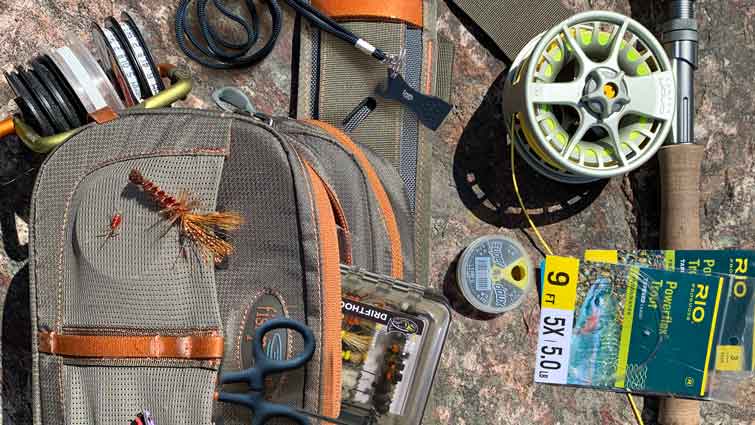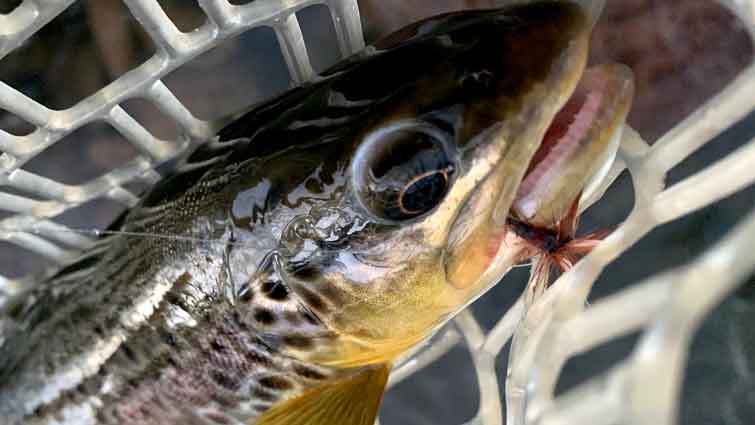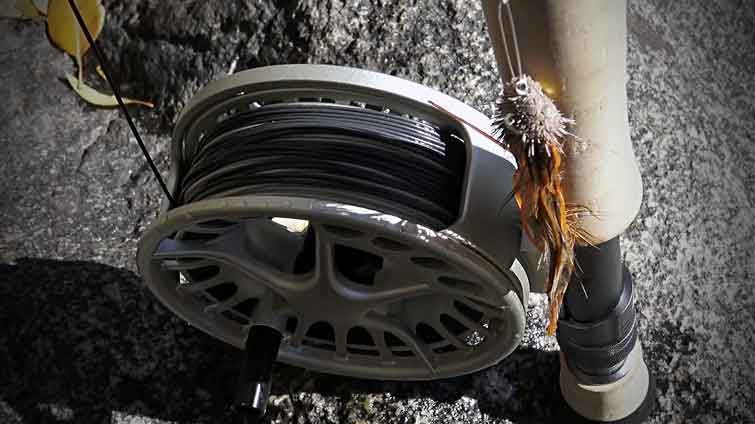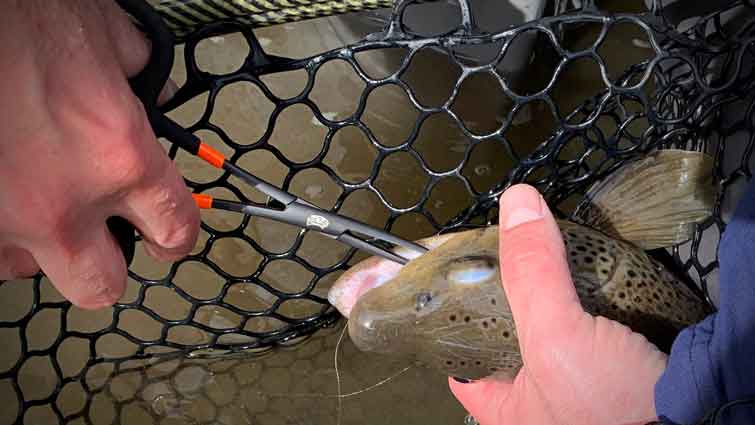This is a question that many anglers face. The answer, however, is not always straightforward. Tippets come in different sizes, and you need to make sure that you are using the right size for the fly you are fishing. There are a few factors to consider when making this decision.
When selecting a tippet, you also need to consider the weight of the line. Heavier lines can handle larger flies and windier conditions, while lighter lines are better for smaller flies and more delicate presentations.

In this article, we will discuss the factors you need to consider when selecting a tippet to add to your fly fishing gear. We will also provide some tips on how to choose the right size tippet for your fly fishing needs.
How to Pick the Right Size Tippet for Fly Fishing
The first thing you need to consider when selecting a tippet is the size of the fly you are using. You want to make sure that the tippet is large enough to handle the fly without kinking or breaking. Tippets come in different sizes, so you need to make sure that you are using the right size for the fly you are fishing.

When choosing a fly fishing tippet, there are several things you need to consider: the size of the fly, the weight of the line, and the type of water. You want to make sure that you are using a tippet that is large enough to handle the fly without kinking or breaking and that is strong enough to handle the weight.
The last thing you need to consider is the type of water you will be fishing in. Heavier tippets are better for fishing in fast-moving water, while lighter tippets are better for fishing in still water.

The tippet and fly fishing leaders are what make the connection between the fly line and the fly nearly undetectable. There is a wide range of forms, sizes, materials, and even colors to choose from when purchasing a fly fishing leader and tippet. The main aim of the leader and tippet is to connect your thick, colored fly line used for casting to the fish with a material that won't frighten them away.
The Fly Fishing Leader and Tippet Measurement System
To make the right selection, it's important to understand fly fishing leaders and tippet measurements. The measurement system is based on the tippet diameter in thousandths of an inch.
Tippet measurements follow the X-system, which means that the size of the tippet gets larger as the number decreases. The amount of tippet material is sometimes recorded in Xs, such as 3X, 4X, 5X, etc., or pounds-force.
These are generally on the order of 03X down to 8X, with 3X being the thickest and toughest and 8X being the thinnest and lightest. So, in a nutshell, the ‘X' size of leader determines how strong and thick or thin the tippet and leader are.
Here is a breakdown of common tippet size and their corresponding diameter, pound-test measurement, and what is commonly fished with each:
|
Tippet Size |
Diameter |
Pounds Test |
Fish Size |
|
03X |
.015 inches |
25 pounds |
Big Game |
|
02X |
.013 inches |
20 pounds |
Larger Salmon |
|
01X |
.012 inches |
18.5 pounds |
Striped Bass |
|
0X |
.011 inches |
15.5 pounds |
Salmon or Steelhead |
|
1X |
.010 inches |
13.5 pounds |
Bonefish |
|
2X |
.009 inches |
11.5 pounds |
Largemouth & Smallmouth Bass |
|
3X |
.008 inches |
8.5 pounds |
Bass & Larger Trout |
|
4X |
.007 inches |
6 pounds |
Average Trout |
|
5X |
.006 inches |
4.75 pounds |
Trout & Panfish |
|
6X |
.005 inches |
3.5 pounds |
Smaller Trout |
|
7X |
.004 inches |
2.5 pounds |
Smaller Trout & Panfish |
|
8X |
.003 inches |
1.75 pounds |
Small Flies |

Materials for Fly Fishing Leaders and Tippets
Tippets and leaders come in a variety of materials, including monofilament, Fluorocarbon, and co-polymer.
Monofilament is by far the most popular material for leaders, as it's strong, flexible, and affordable. Fluorocarbon leaders are gaining popularity due to their invisibility in water and high abrasion resistance. Co-polymer leaders are also gaining in popularity because they're more affordable than Fluorocarbon and have good abrasion resistance.

Monofilament
Monofilament is the most popular choice for tippets because it is strong, relatively inexpensive, and easy to find. Monofilament is a single strand of plastic and is available in a variety of diameters. The diameter you choose depends on the weight of fly you're using and the size of the stream.
When to use monofilament:
- When anglers are fishing any type of floating dry flies or poppers.
- Monofilament floats well when treated with a floatant paste.
Fluorocarbon
Fluorocarbon is a good choice for tippets because it is nearly invisible in the water, making it a favorite among fly fishermen. It is more expensive than monofilament, however it is almost invisible underwater and has greater abrasion resistance.
When to use Fluorocarbon:
- When Nymphing, or Streamer Fishing
- With long leaders
- In windy conditions
Co-Polymer
Co-polymer is a newer material that offers the benefits of both monofilament and Fluorocarbon. It floats well and is nearly invisible in the water, making it a good choice for most fishing applications. It is more expensive than monofilament and Fluorocarbon and can be difficult to find.
When to use co-polymer:
- With dry flies with diameters greater than 0.14 mm
- When fishing large surface patterns
- Fishing nymphs and wets slowly when the angler wishes to keep the flies high in the water column
Which tippet material you choose depends on the conditions you'll be fishing in and your personal preferences. Monofilament is a good all-around choice, while Fluorocarbon is ideal for clear water conditions. Co-polymer is a newer material that offers the best of both worlds, making it a good choice for most fishing applications.

Whichever tippet material you choose, make sure to match the size to the fly you're using. A too-large tippet will decrease the sensitivity of your line and make it more difficult to detect strikes from fish. A too-small tippet will make it difficult to land fish.
When selecting a tippet material, you'll also need to consider the size and strength of the fly line you're using. Heavier fly lines can support larger tippets, while lighter fly lines require smaller tippets for optimum performance. The strength of a tippet is measured in pounds-test (lb.-test). Most trout fishing is done with tippets ranging from 2-6 lb.-test, but you may need heavier or lighter tippets depending on the species you're targeting and the conditions you're fishing in.
Frequently Asked Questions
Here are some frequently asked questions about fly fishing tippets, their sizes, and materials used.
What Is Tippet In Fly Fishing?
Tippet is an integral part of your fly fishing gear. They are the section of line between the fly line or leader and the fly. Tippet comes in a variety of materials, each with its own benefits and drawbacks.
A tippet is a specific measurement of the monofilament or fluorocarbon line that is attached to the end of the leader, from which you secure the fly. The tippet is generally the smallest gauge line on your rig and goes unnoticed by fish. Tippet also has a lot of give, allowing your fly to float or swim more naturally in water.
Choosing the right tippet material is important for two reasons. First, the tippet needs to be strong enough to withstand the fighting power of a fish without breaking. Second, the tippet needs to be thin enough to allow you to cast a light fly accurately. Heavier tippets are more difficult to cast, while smaller tippets can be too weak to land fish.

How Do You Know What Size Tippet to Use?
First, there are several circumstances that determine the tippet size you should use. The size of the fly, the weight of the line, and the type of water you are fishing all play a role in deciding what size tippet to use.
In general, the rule of three can be used to determine the size tippet needed for your fly. If you're fishing a size 12 fly, divide by three and use a 4X tippet. Divide by three and use 6X or even 7X tippet if you're fishing a size 20 fly.

There are general rules of thumb that can help you choose the right tippet size. In general, you should use a smaller tippet when fishing smaller flies and a larger tippet when fishing larger flies. You should also use a heavier tippet in fast-moving water and a lighter tippet in slow-moving water.
The type of fly you are using also matters. Wet flies, for example, tend to be heavier than dry flies and nymphs. If you're fishing a wet fly, you'll typically need a heavier tippet than if you're fishing a dry fly or a nymph.

What Size Tippet Should I Use for Trout?
When fishing trout, you should use a tippet size that is about one-third the size of the fly. For example, if you are using a size 12 fly, you should use a tippet size of 4 or 5.
The majority of trout-fishing scenarios may be covered with a 4X-6X tippet. Warmwater species can generally utilize 0X to 3X tippet without difficulty. Tippets from one fly may also be attached to another to fish multiple flies at the same time in the case of dropper rigs or tandem fly rigs.
Do You Really Need a Tippet?
With all of the gear required for fly fishing, the question of 'Do I really need a tippet?' often comes up. The answer is YES!
A tippet is a vital component that must be included when tying fishing flies to the tapered leader of the main fly line. Casting flies accurately with good technique and precision is quite difficult without a tippet.

Do You Need a Leader and a Tippet?
The leader is a section of heavy nylon or fluorocarbon line that is typically tapered from thick to thin and attaches to the fly line. The tippet is then attached to the leader. You can't attach your fly directly to the line because fish would see it.
You'll need a leader and tippet to form an almost transparent link between the line and the fly. The leader is generally attached to the line with a big diameter end, while the tip of the tippet points at the insect.
How Do You Attach a Tippet to a Fly Line (Leader)?
To tie a tippet to a leader, you'll need to use a double surgeon's knot. The Double Surgeons' knot are very strong and will hold up under a lot of stress.
To tie a double surgeon's knot:
- Overlap the ends of the tippet and leader
- Form a loop and pass one end through it
- Pass it through the same way once more
- Tighten by pulling both ends
- Trim the excess line
Learning how to tie a surgeon's knot is essential for fly fishing. Once you've mastered this knot, you'll be ready to tackle any fly fishing situation.
Conclusion
When choosing a tippet for fly fishing, it's important to select the right size and strength. You'll also need to make sure that the tippet is properly attached to your fly line and leader. By following these simple tips, you can ensure that you're prepared for any fishing situation.
The type of water you are fishing in is one of the most important things to consider when choosing a tippet and fly fishing leader. Heavier leaders are better for fast-moving water, while lighter leaders are better for still water. There is also a wide range of materials, sizes, and colors to choose from when selecting a fly fishing leader and tippet. Make sure you select the right leader and tippet for the type of water you will be fishing in to ensure your success on the stream or river.






